Comprehensive Report on Human Resource Strategies in Retail Sector
VerifiedAdded on 2020/07/23
|8
|2030
|51
Report
AI Summary
This report delves into the critical aspects of human resource strategies within the retail industry. It begins by examining various strategies for delivering human resource services, including traditional models and Ulrich's three-legged stool approach, highlighting the importance of talent and strategic planning. The report then explores methods for managing the delivery of these services, emphasizing employee commitment, conflict resolution, and the significance of strong employee relations and efficient time management. Furthermore, it addresses the evaluation of human resource service delivery, detailing methods such as employee surveys, HR audits, and return on investment analysis. Finally, the report underscores the importance of integrating business ethics into human resource practices, ensuring ethical conduct, job security, and performance-based rewards within the retail sector. The report emphasizes the need for proper strategies to achieve organizational objectives.
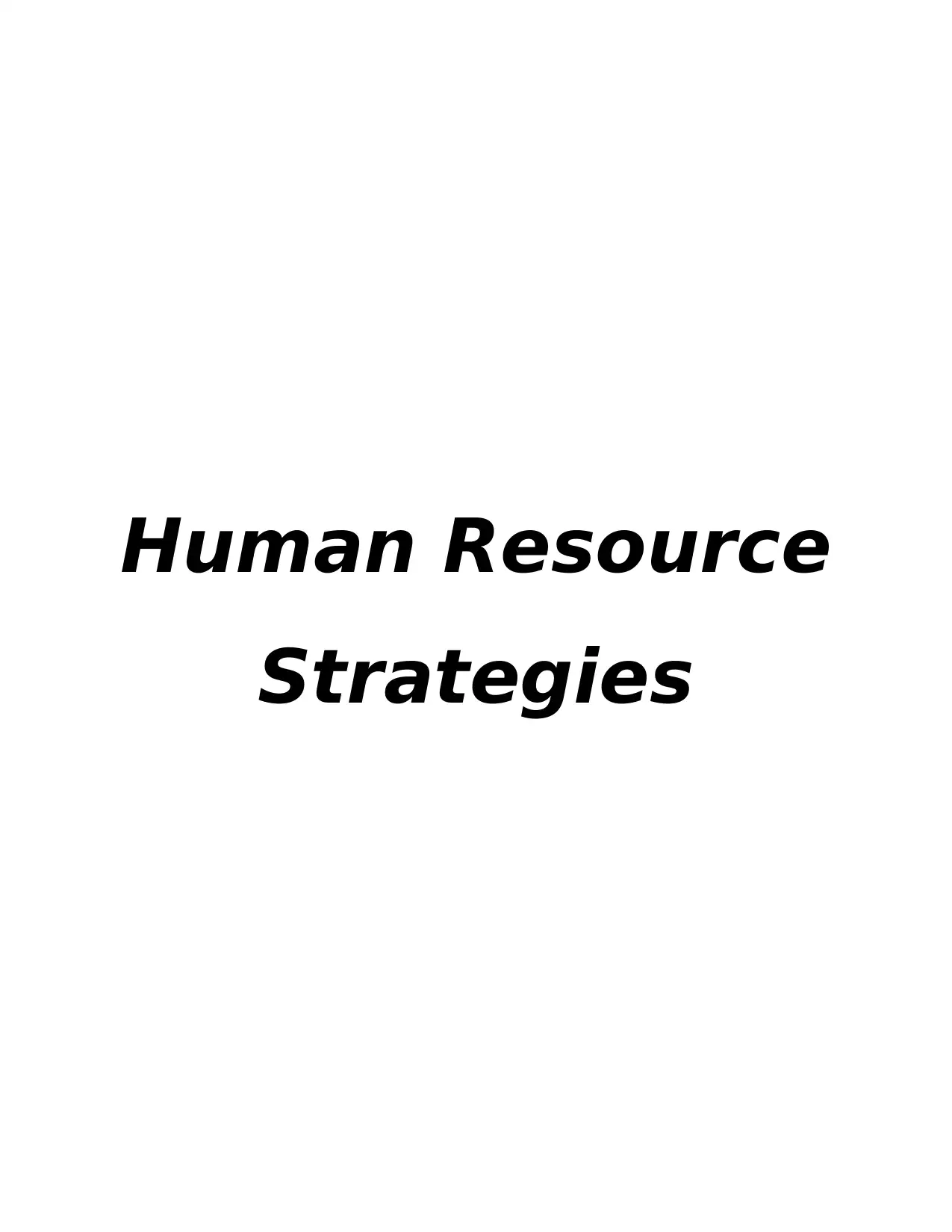
Human Resource
Strategies
Strategies
Paraphrase This Document
Need a fresh take? Get an instant paraphrase of this document with our AI Paraphraser
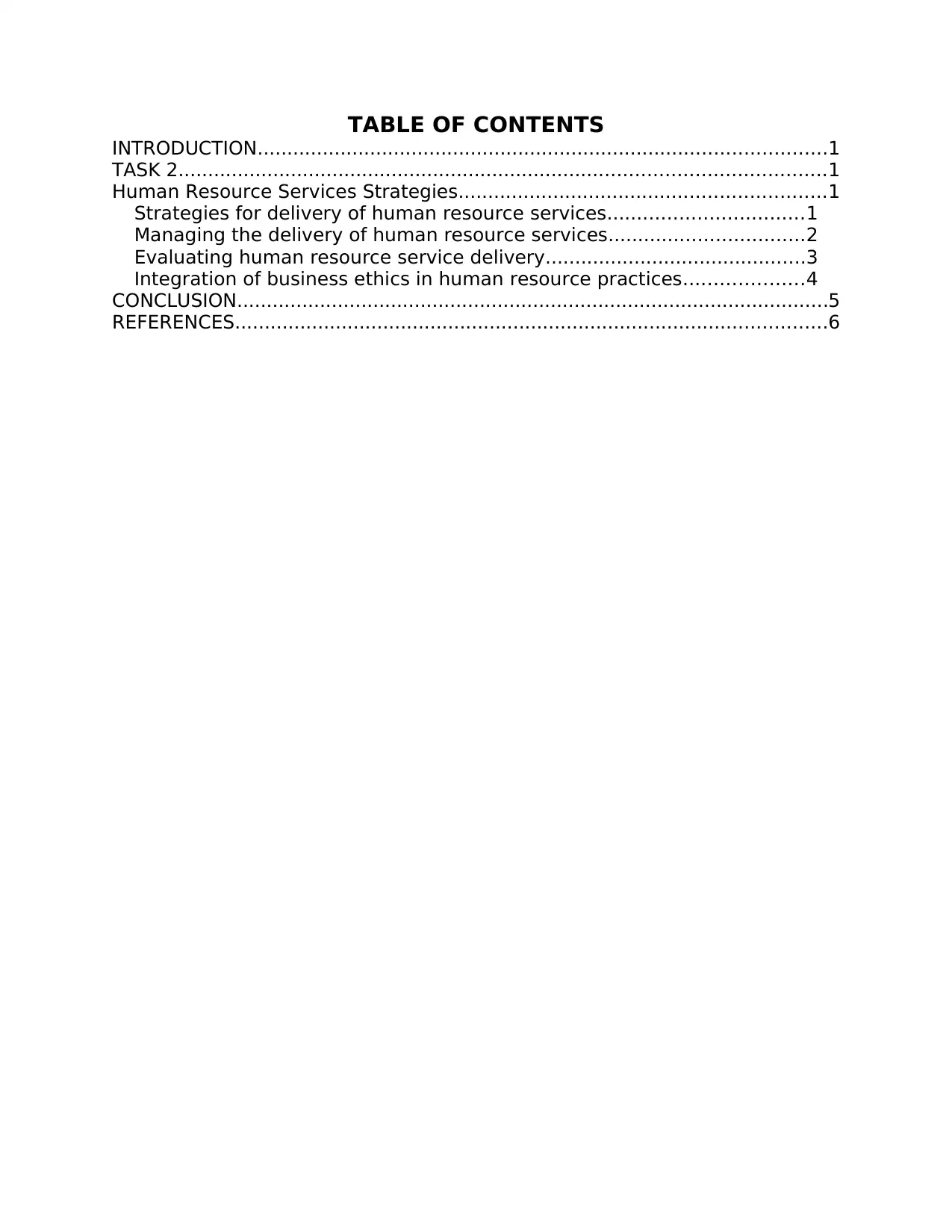
TABLE OF CONTENTS
INTRODUCTION................................................................................................1
TASK 2.............................................................................................................1
Human Resource Services Strategies..............................................................1
Strategies for delivery of human resource services.................................1
Managing the delivery of human resource services.................................2
Evaluating human resource service delivery............................................3
Integration of business ethics in human resource practices....................4
CONCLUSION....................................................................................................5
REFERENCES....................................................................................................6
INTRODUCTION................................................................................................1
TASK 2.............................................................................................................1
Human Resource Services Strategies..............................................................1
Strategies for delivery of human resource services.................................1
Managing the delivery of human resource services.................................2
Evaluating human resource service delivery............................................3
Integration of business ethics in human resource practices....................4
CONCLUSION....................................................................................................5
REFERENCES....................................................................................................6
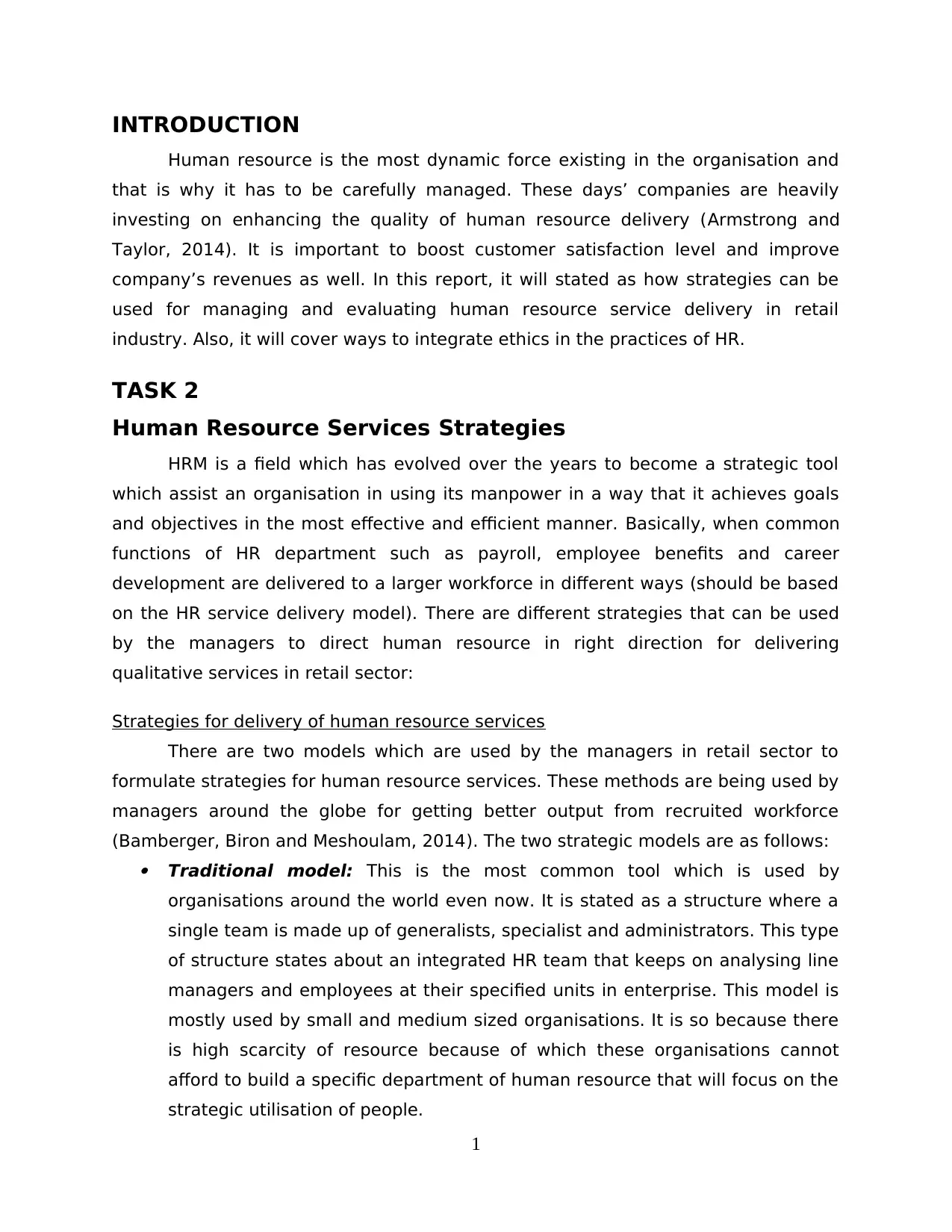
INTRODUCTION
Human resource is the most dynamic force existing in the organisation and
that is why it has to be carefully managed. These days’ companies are heavily
investing on enhancing the quality of human resource delivery (Armstrong and
Taylor, 2014). It is important to boost customer satisfaction level and improve
company’s revenues as well. In this report, it will stated as how strategies can be
used for managing and evaluating human resource service delivery in retail
industry. Also, it will cover ways to integrate ethics in the practices of HR.
TASK 2
Human Resource Services Strategies
HRM is a field which has evolved over the years to become a strategic tool
which assist an organisation in using its manpower in a way that it achieves goals
and objectives in the most effective and efficient manner. Basically, when common
functions of HR department such as payroll, employee benefits and career
development are delivered to a larger workforce in different ways (should be based
on the HR service delivery model). There are different strategies that can be used
by the managers to direct human resource in right direction for delivering
qualitative services in retail sector:
Strategies for delivery of human resource services
There are two models which are used by the managers in retail sector to
formulate strategies for human resource services. These methods are being used by
managers around the globe for getting better output from recruited workforce
(Bamberger, Biron and Meshoulam, 2014). The two strategic models are as follows: Traditional model: This is the most common tool which is used by
organisations around the world even now. It is stated as a structure where a
single team is made up of generalists, specialist and administrators. This type
of structure states about an integrated HR team that keeps on analysing line
managers and employees at their specified units in enterprise. This model is
mostly used by small and medium sized organisations. It is so because there
is high scarcity of resource because of which these organisations cannot
afford to build a specific department of human resource that will focus on the
strategic utilisation of people.
1
Human resource is the most dynamic force existing in the organisation and
that is why it has to be carefully managed. These days’ companies are heavily
investing on enhancing the quality of human resource delivery (Armstrong and
Taylor, 2014). It is important to boost customer satisfaction level and improve
company’s revenues as well. In this report, it will stated as how strategies can be
used for managing and evaluating human resource service delivery in retail
industry. Also, it will cover ways to integrate ethics in the practices of HR.
TASK 2
Human Resource Services Strategies
HRM is a field which has evolved over the years to become a strategic tool
which assist an organisation in using its manpower in a way that it achieves goals
and objectives in the most effective and efficient manner. Basically, when common
functions of HR department such as payroll, employee benefits and career
development are delivered to a larger workforce in different ways (should be based
on the HR service delivery model). There are different strategies that can be used
by the managers to direct human resource in right direction for delivering
qualitative services in retail sector:
Strategies for delivery of human resource services
There are two models which are used by the managers in retail sector to
formulate strategies for human resource services. These methods are being used by
managers around the globe for getting better output from recruited workforce
(Bamberger, Biron and Meshoulam, 2014). The two strategic models are as follows: Traditional model: This is the most common tool which is used by
organisations around the world even now. It is stated as a structure where a
single team is made up of generalists, specialist and administrators. This type
of structure states about an integrated HR team that keeps on analysing line
managers and employees at their specified units in enterprise. This model is
mostly used by small and medium sized organisations. It is so because there
is high scarcity of resource because of which these organisations cannot
afford to build a specific department of human resource that will focus on the
strategic utilisation of people.
1
⊘ This is a preview!⊘
Do you want full access?
Subscribe today to unlock all pages.

Trusted by 1+ million students worldwide
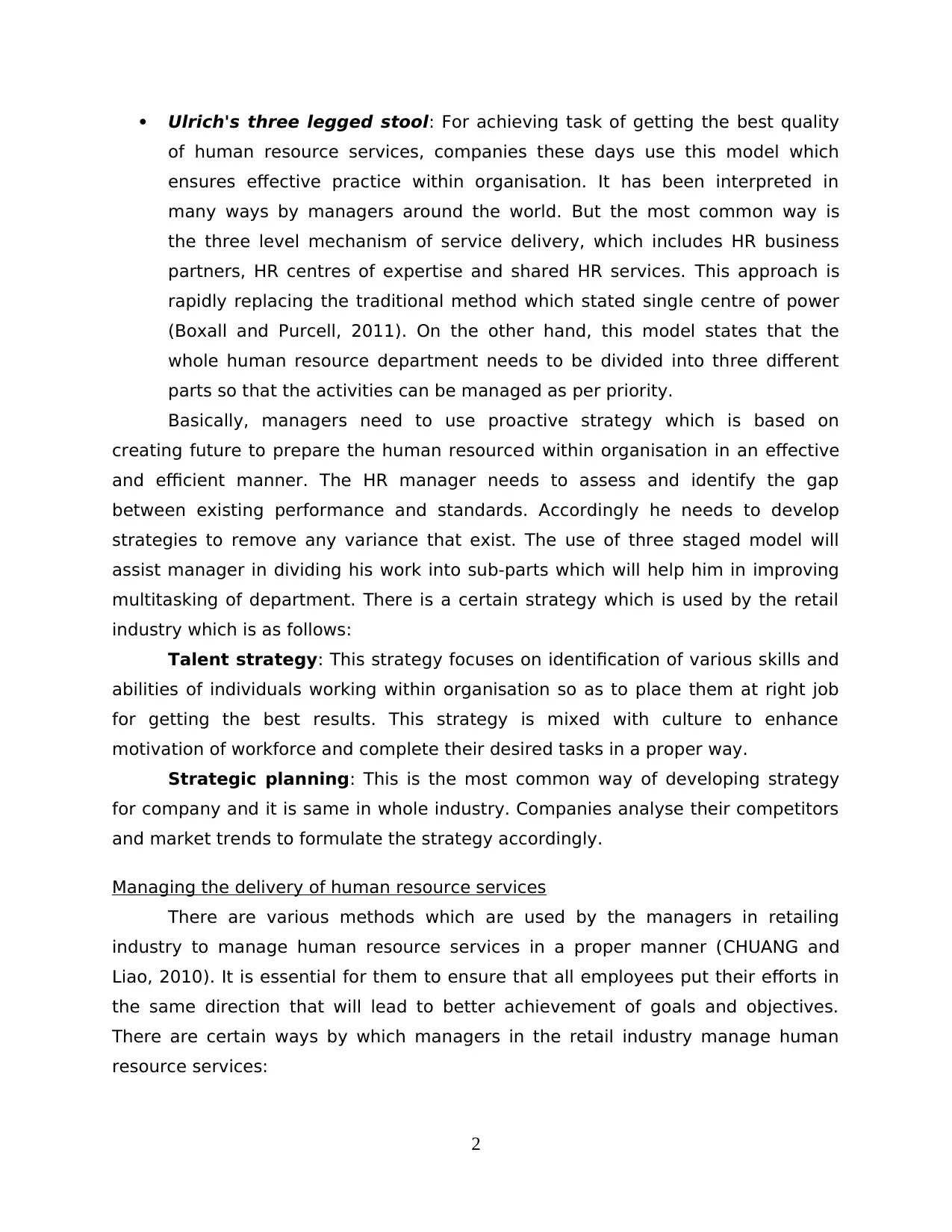
Ulrich's three legged stool: For achieving task of getting the best quality
of human resource services, companies these days use this model which
ensures effective practice within organisation. It has been interpreted in
many ways by managers around the world. But the most common way is
the three level mechanism of service delivery, which includes HR business
partners, HR centres of expertise and shared HR services. This approach is
rapidly replacing the traditional method which stated single centre of power
(Boxall and Purcell, 2011). On the other hand, this model states that the
whole human resource department needs to be divided into three different
parts so that the activities can be managed as per priority.
Basically, managers need to use proactive strategy which is based on
creating future to prepare the human resourced within organisation in an effective
and efficient manner. The HR manager needs to assess and identify the gap
between existing performance and standards. Accordingly he needs to develop
strategies to remove any variance that exist. The use of three staged model will
assist manager in dividing his work into sub-parts which will help him in improving
multitasking of department. There is a certain strategy which is used by the retail
industry which is as follows:
Talent strategy: This strategy focuses on identification of various skills and
abilities of individuals working within organisation so as to place them at right job
for getting the best results. This strategy is mixed with culture to enhance
motivation of workforce and complete their desired tasks in a proper way.
Strategic planning: This is the most common way of developing strategy
for company and it is same in whole industry. Companies analyse their competitors
and market trends to formulate the strategy accordingly.
Managing the delivery of human resource services
There are various methods which are used by the managers in retailing
industry to manage human resource services in a proper manner (CHUANG and
Liao, 2010). It is essential for them to ensure that all employees put their efforts in
the same direction that will lead to better achievement of goals and objectives.
There are certain ways by which managers in the retail industry manage human
resource services:
2
of human resource services, companies these days use this model which
ensures effective practice within organisation. It has been interpreted in
many ways by managers around the world. But the most common way is
the three level mechanism of service delivery, which includes HR business
partners, HR centres of expertise and shared HR services. This approach is
rapidly replacing the traditional method which stated single centre of power
(Boxall and Purcell, 2011). On the other hand, this model states that the
whole human resource department needs to be divided into three different
parts so that the activities can be managed as per priority.
Basically, managers need to use proactive strategy which is based on
creating future to prepare the human resourced within organisation in an effective
and efficient manner. The HR manager needs to assess and identify the gap
between existing performance and standards. Accordingly he needs to develop
strategies to remove any variance that exist. The use of three staged model will
assist manager in dividing his work into sub-parts which will help him in improving
multitasking of department. There is a certain strategy which is used by the retail
industry which is as follows:
Talent strategy: This strategy focuses on identification of various skills and
abilities of individuals working within organisation so as to place them at right job
for getting the best results. This strategy is mixed with culture to enhance
motivation of workforce and complete their desired tasks in a proper way.
Strategic planning: This is the most common way of developing strategy
for company and it is same in whole industry. Companies analyse their competitors
and market trends to formulate the strategy accordingly.
Managing the delivery of human resource services
There are various methods which are used by the managers in retailing
industry to manage human resource services in a proper manner (CHUANG and
Liao, 2010). It is essential for them to ensure that all employees put their efforts in
the same direction that will lead to better achievement of goals and objectives.
There are certain ways by which managers in the retail industry manage human
resource services:
2
Paraphrase This Document
Need a fresh take? Get an instant paraphrase of this document with our AI Paraphraser
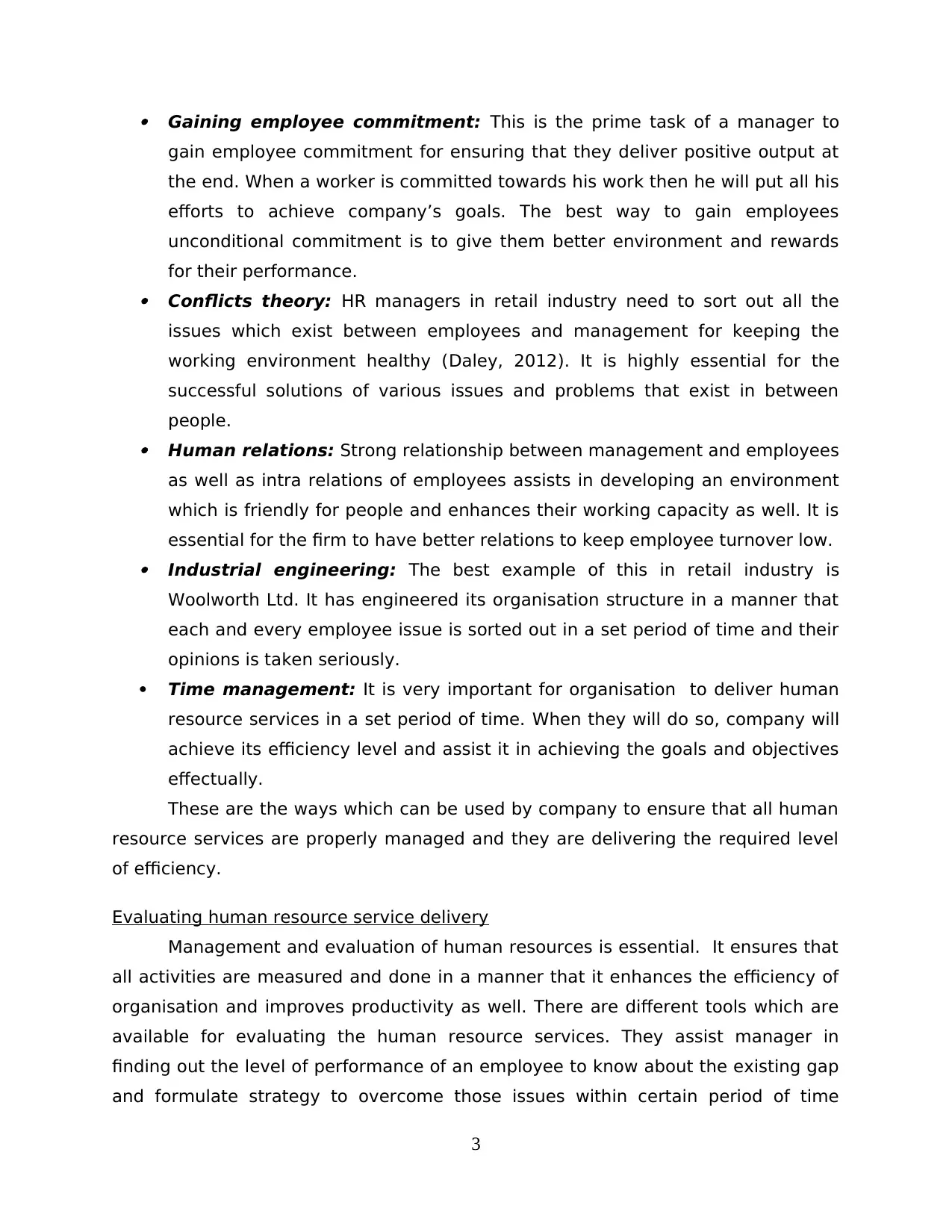
Gaining employee commitment: This is the prime task of a manager to
gain employee commitment for ensuring that they deliver positive output at
the end. When a worker is committed towards his work then he will put all his
efforts to achieve company’s goals. The best way to gain employees
unconditional commitment is to give them better environment and rewards
for their performance. Conflicts theory: HR managers in retail industry need to sort out all the
issues which exist between employees and management for keeping the
working environment healthy (Daley, 2012). It is highly essential for the
successful solutions of various issues and problems that exist in between
people. Human relations: Strong relationship between management and employees
as well as intra relations of employees assists in developing an environment
which is friendly for people and enhances their working capacity as well. It is
essential for the firm to have better relations to keep employee turnover low. Industrial engineering: The best example of this in retail industry is
Woolworth Ltd. It has engineered its organisation structure in a manner that
each and every employee issue is sorted out in a set period of time and their
opinions is taken seriously.
Time management: It is very important for organisation to deliver human
resource services in a set period of time. When they will do so, company will
achieve its efficiency level and assist it in achieving the goals and objectives
effectually.
These are the ways which can be used by company to ensure that all human
resource services are properly managed and they are delivering the required level
of efficiency.
Evaluating human resource service delivery
Management and evaluation of human resources is essential. It ensures that
all activities are measured and done in a manner that it enhances the efficiency of
organisation and improves productivity as well. There are different tools which are
available for evaluating the human resource services. They assist manager in
finding out the level of performance of an employee to know about the existing gap
and formulate strategy to overcome those issues within certain period of time
3
gain employee commitment for ensuring that they deliver positive output at
the end. When a worker is committed towards his work then he will put all his
efforts to achieve company’s goals. The best way to gain employees
unconditional commitment is to give them better environment and rewards
for their performance. Conflicts theory: HR managers in retail industry need to sort out all the
issues which exist between employees and management for keeping the
working environment healthy (Daley, 2012). It is highly essential for the
successful solutions of various issues and problems that exist in between
people. Human relations: Strong relationship between management and employees
as well as intra relations of employees assists in developing an environment
which is friendly for people and enhances their working capacity as well. It is
essential for the firm to have better relations to keep employee turnover low. Industrial engineering: The best example of this in retail industry is
Woolworth Ltd. It has engineered its organisation structure in a manner that
each and every employee issue is sorted out in a set period of time and their
opinions is taken seriously.
Time management: It is very important for organisation to deliver human
resource services in a set period of time. When they will do so, company will
achieve its efficiency level and assist it in achieving the goals and objectives
effectually.
These are the ways which can be used by company to ensure that all human
resource services are properly managed and they are delivering the required level
of efficiency.
Evaluating human resource service delivery
Management and evaluation of human resources is essential. It ensures that
all activities are measured and done in a manner that it enhances the efficiency of
organisation and improves productivity as well. There are different tools which are
available for evaluating the human resource services. They assist manager in
finding out the level of performance of an employee to know about the existing gap
and formulate strategy to overcome those issues within certain period of time
3
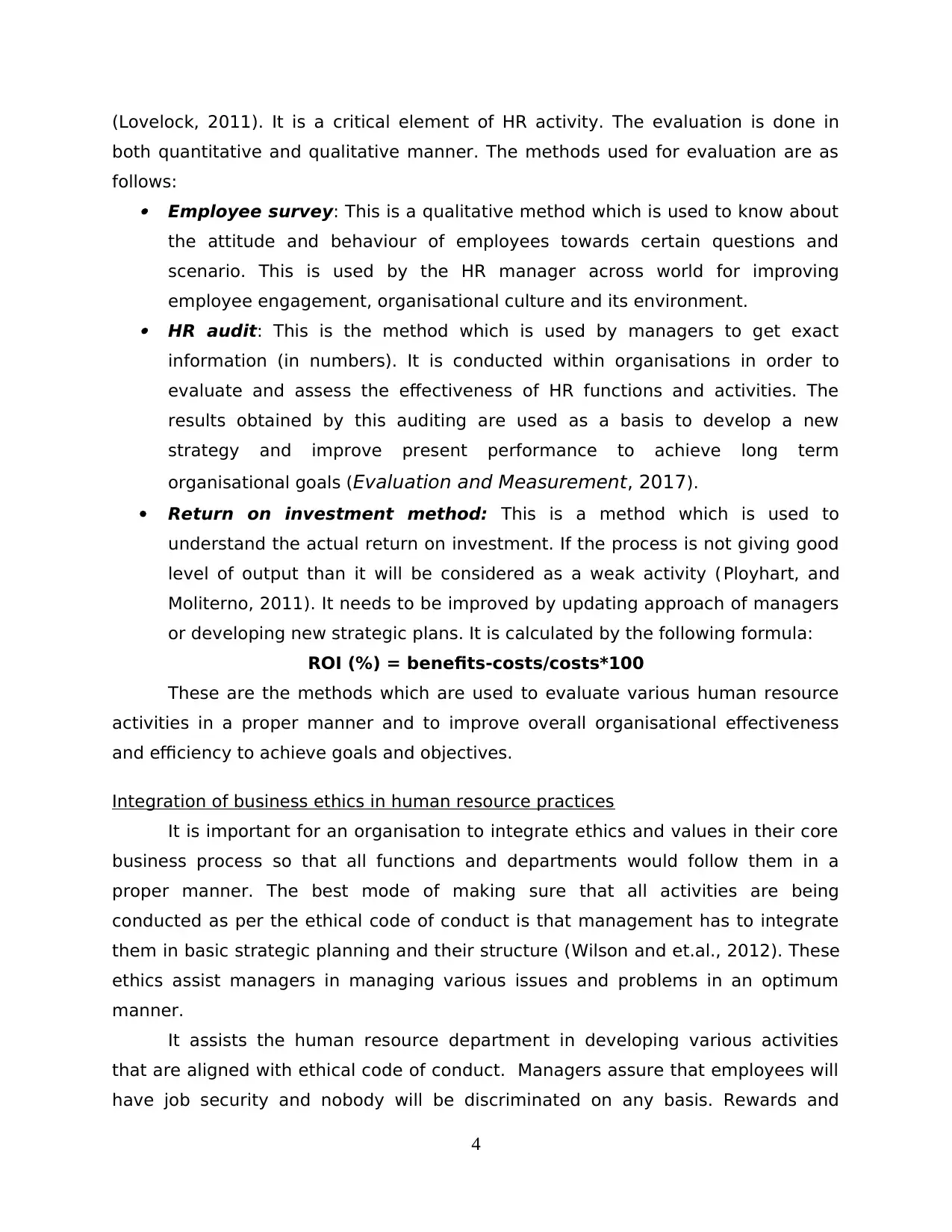
(Lovelock, 2011). It is a critical element of HR activity. The evaluation is done in
both quantitative and qualitative manner. The methods used for evaluation are as
follows: Employee survey: This is a qualitative method which is used to know about
the attitude and behaviour of employees towards certain questions and
scenario. This is used by the HR manager across world for improving
employee engagement, organisational culture and its environment. HR audit: This is the method which is used by managers to get exact
information (in numbers). It is conducted within organisations in order to
evaluate and assess the effectiveness of HR functions and activities. The
results obtained by this auditing are used as a basis to develop a new
strategy and improve present performance to achieve long term
organisational goals (Evaluation and Measurement, 2017).
Return on investment method: This is a method which is used to
understand the actual return on investment. If the process is not giving good
level of output than it will be considered as a weak activity (Ployhart, and
Moliterno, 2011). It needs to be improved by updating approach of managers
or developing new strategic plans. It is calculated by the following formula:
ROI (%) = benefits-costs/costs*100
These are the methods which are used to evaluate various human resource
activities in a proper manner and to improve overall organisational effectiveness
and efficiency to achieve goals and objectives.
Integration of business ethics in human resource practices
It is important for an organisation to integrate ethics and values in their core
business process so that all functions and departments would follow them in a
proper manner. The best mode of making sure that all activities are being
conducted as per the ethical code of conduct is that management has to integrate
them in basic strategic planning and their structure (Wilson and et.al., 2012). These
ethics assist managers in managing various issues and problems in an optimum
manner.
It assists the human resource department in developing various activities
that are aligned with ethical code of conduct. Managers assure that employees will
have job security and nobody will be discriminated on any basis. Rewards and
4
both quantitative and qualitative manner. The methods used for evaluation are as
follows: Employee survey: This is a qualitative method which is used to know about
the attitude and behaviour of employees towards certain questions and
scenario. This is used by the HR manager across world for improving
employee engagement, organisational culture and its environment. HR audit: This is the method which is used by managers to get exact
information (in numbers). It is conducted within organisations in order to
evaluate and assess the effectiveness of HR functions and activities. The
results obtained by this auditing are used as a basis to develop a new
strategy and improve present performance to achieve long term
organisational goals (Evaluation and Measurement, 2017).
Return on investment method: This is a method which is used to
understand the actual return on investment. If the process is not giving good
level of output than it will be considered as a weak activity (Ployhart, and
Moliterno, 2011). It needs to be improved by updating approach of managers
or developing new strategic plans. It is calculated by the following formula:
ROI (%) = benefits-costs/costs*100
These are the methods which are used to evaluate various human resource
activities in a proper manner and to improve overall organisational effectiveness
and efficiency to achieve goals and objectives.
Integration of business ethics in human resource practices
It is important for an organisation to integrate ethics and values in their core
business process so that all functions and departments would follow them in a
proper manner. The best mode of making sure that all activities are being
conducted as per the ethical code of conduct is that management has to integrate
them in basic strategic planning and their structure (Wilson and et.al., 2012). These
ethics assist managers in managing various issues and problems in an optimum
manner.
It assists the human resource department in developing various activities
that are aligned with ethical code of conduct. Managers assure that employees will
have job security and nobody will be discriminated on any basis. Rewards and
4
⊘ This is a preview!⊘
Do you want full access?
Subscribe today to unlock all pages.

Trusted by 1+ million students worldwide
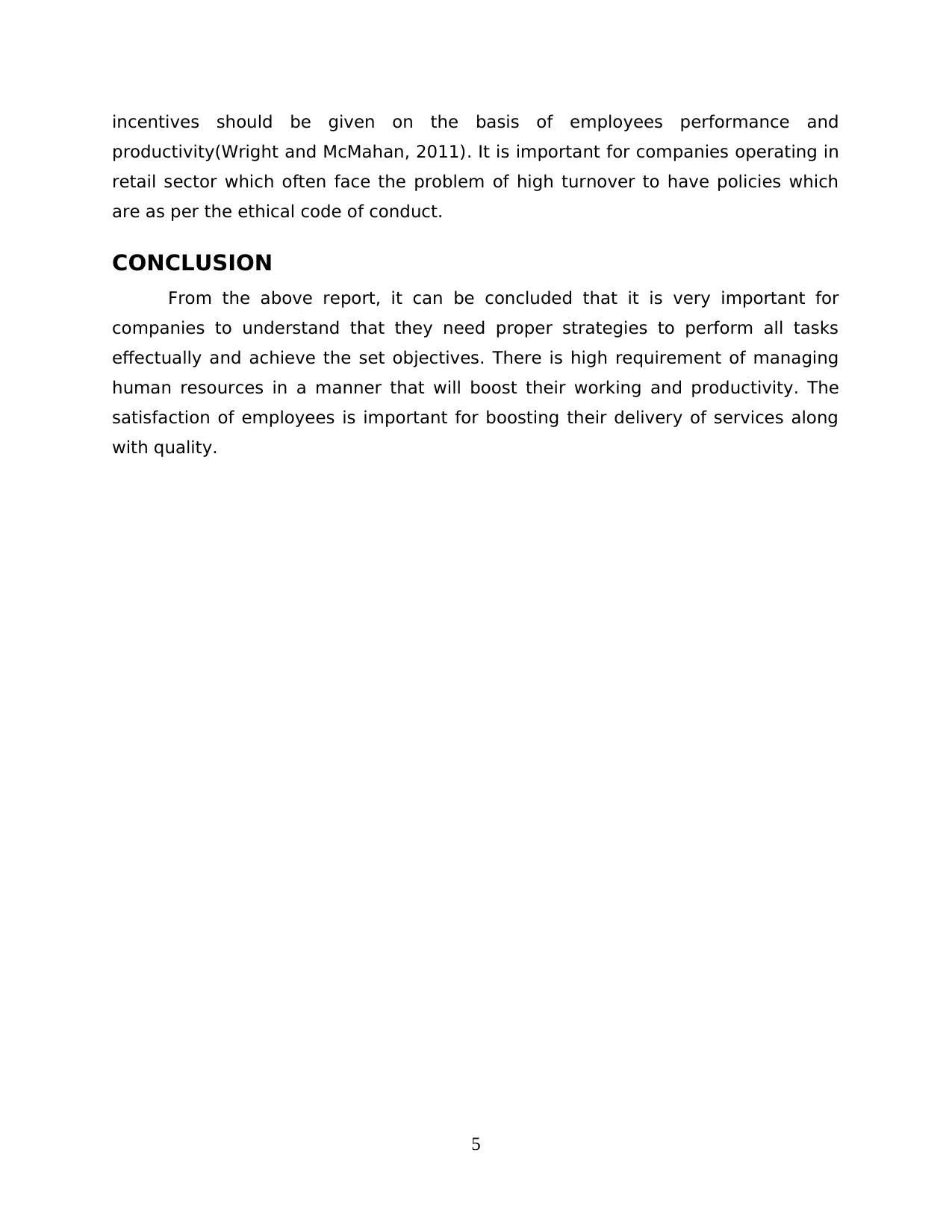
incentives should be given on the basis of employees performance and
productivity(Wright and McMahan, 2011). It is important for companies operating in
retail sector which often face the problem of high turnover to have policies which
are as per the ethical code of conduct.
CONCLUSION
From the above report, it can be concluded that it is very important for
companies to understand that they need proper strategies to perform all tasks
effectually and achieve the set objectives. There is high requirement of managing
human resources in a manner that will boost their working and productivity. The
satisfaction of employees is important for boosting their delivery of services along
with quality.
5
productivity(Wright and McMahan, 2011). It is important for companies operating in
retail sector which often face the problem of high turnover to have policies which
are as per the ethical code of conduct.
CONCLUSION
From the above report, it can be concluded that it is very important for
companies to understand that they need proper strategies to perform all tasks
effectually and achieve the set objectives. There is high requirement of managing
human resources in a manner that will boost their working and productivity. The
satisfaction of employees is important for boosting their delivery of services along
with quality.
5
Paraphrase This Document
Need a fresh take? Get an instant paraphrase of this document with our AI Paraphraser
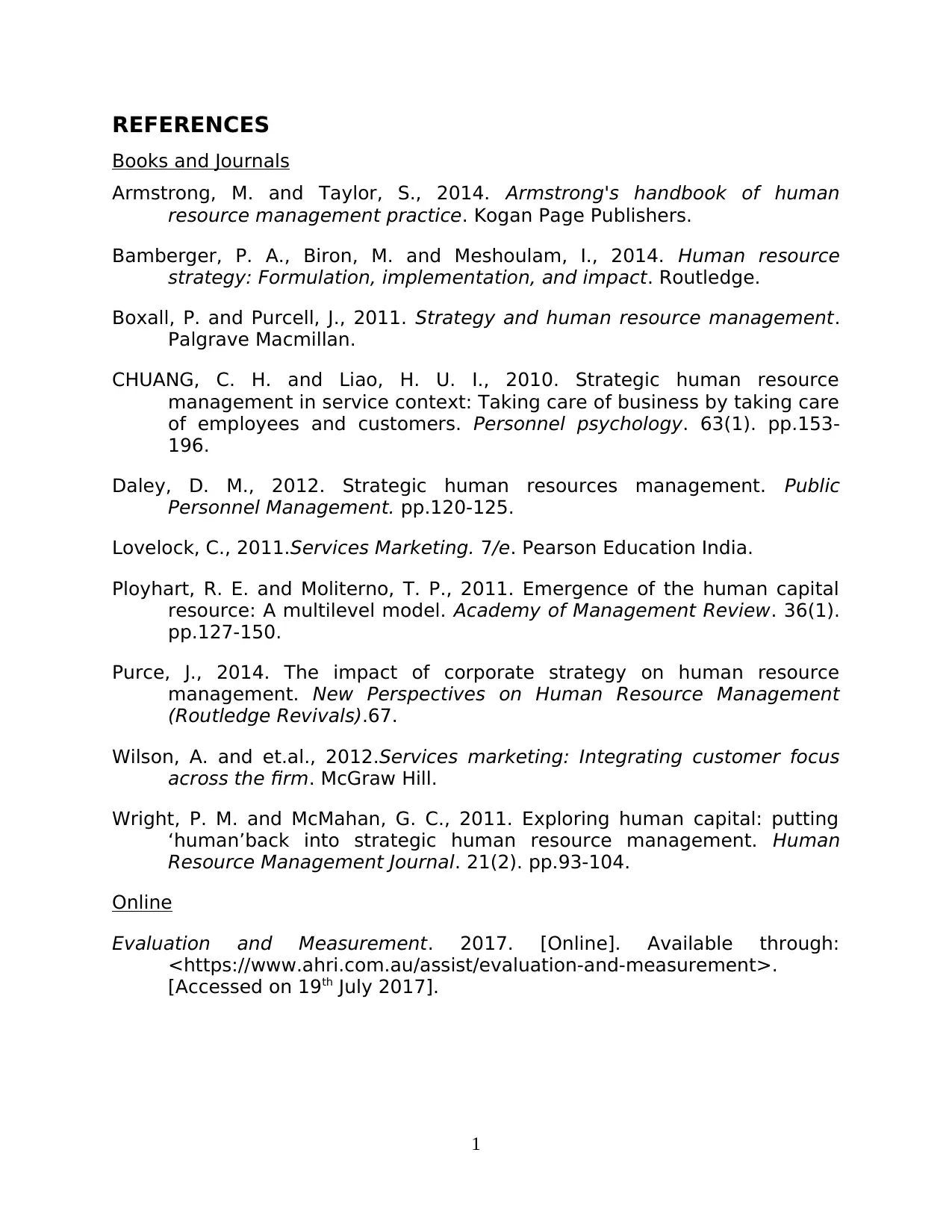
REFERENCES
Books and Journals
Armstrong, M. and Taylor, S., 2014. Armstrong's handbook of human
resource management practice. Kogan Page Publishers.
Bamberger, P. A., Biron, M. and Meshoulam, I., 2014. Human resource
strategy: Formulation, implementation, and impact. Routledge.
Boxall, P. and Purcell, J., 2011. Strategy and human resource management.
Palgrave Macmillan.
CHUANG, C. H. and Liao, H. U. I., 2010. Strategic human resource
management in service context: Taking care of business by taking care
of employees and customers. Personnel psychology. 63(1). pp.153-
196.
Daley, D. M., 2012. Strategic human resources management. Public
Personnel Management. pp.120-125.
Lovelock, C., 2011.Services Marketing. 7/e. Pearson Education India.
Ployhart, R. E. and Moliterno, T. P., 2011. Emergence of the human capital
resource: A multilevel model. Academy of Management Review. 36(1).
pp.127-150.
Purce, J., 2014. The impact of corporate strategy on human resource
management. New Perspectives on Human Resource Management
(Routledge Revivals).67.
Wilson, A. and et.al., 2012.Services marketing: Integrating customer focus
across the firm. McGraw Hill.
Wright, P. M. and McMahan, G. C., 2011. Exploring human capital: putting
‘human’back into strategic human resource management. Human
Resource Management Journal. 21(2). pp.93-104.
Online
Evaluation and Measurement. 2017. [Online]. Available through:
<https://www.ahri.com.au/assist/evaluation-and-measurement>.
[Accessed on 19th July 2017].
1
Books and Journals
Armstrong, M. and Taylor, S., 2014. Armstrong's handbook of human
resource management practice. Kogan Page Publishers.
Bamberger, P. A., Biron, M. and Meshoulam, I., 2014. Human resource
strategy: Formulation, implementation, and impact. Routledge.
Boxall, P. and Purcell, J., 2011. Strategy and human resource management.
Palgrave Macmillan.
CHUANG, C. H. and Liao, H. U. I., 2010. Strategic human resource
management in service context: Taking care of business by taking care
of employees and customers. Personnel psychology. 63(1). pp.153-
196.
Daley, D. M., 2012. Strategic human resources management. Public
Personnel Management. pp.120-125.
Lovelock, C., 2011.Services Marketing. 7/e. Pearson Education India.
Ployhart, R. E. and Moliterno, T. P., 2011. Emergence of the human capital
resource: A multilevel model. Academy of Management Review. 36(1).
pp.127-150.
Purce, J., 2014. The impact of corporate strategy on human resource
management. New Perspectives on Human Resource Management
(Routledge Revivals).67.
Wilson, A. and et.al., 2012.Services marketing: Integrating customer focus
across the firm. McGraw Hill.
Wright, P. M. and McMahan, G. C., 2011. Exploring human capital: putting
‘human’back into strategic human resource management. Human
Resource Management Journal. 21(2). pp.93-104.
Online
Evaluation and Measurement. 2017. [Online]. Available through:
<https://www.ahri.com.au/assist/evaluation-and-measurement>.
[Accessed on 19th July 2017].
1
1 out of 8
Related Documents
Your All-in-One AI-Powered Toolkit for Academic Success.
+13062052269
info@desklib.com
Available 24*7 on WhatsApp / Email
![[object Object]](/_next/static/media/star-bottom.7253800d.svg)
Unlock your academic potential
Copyright © 2020–2025 A2Z Services. All Rights Reserved. Developed and managed by ZUCOL.




